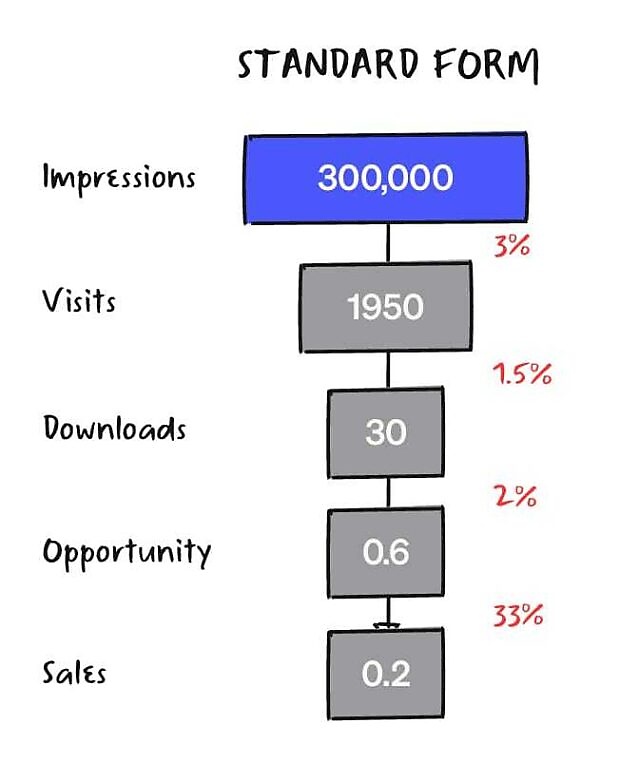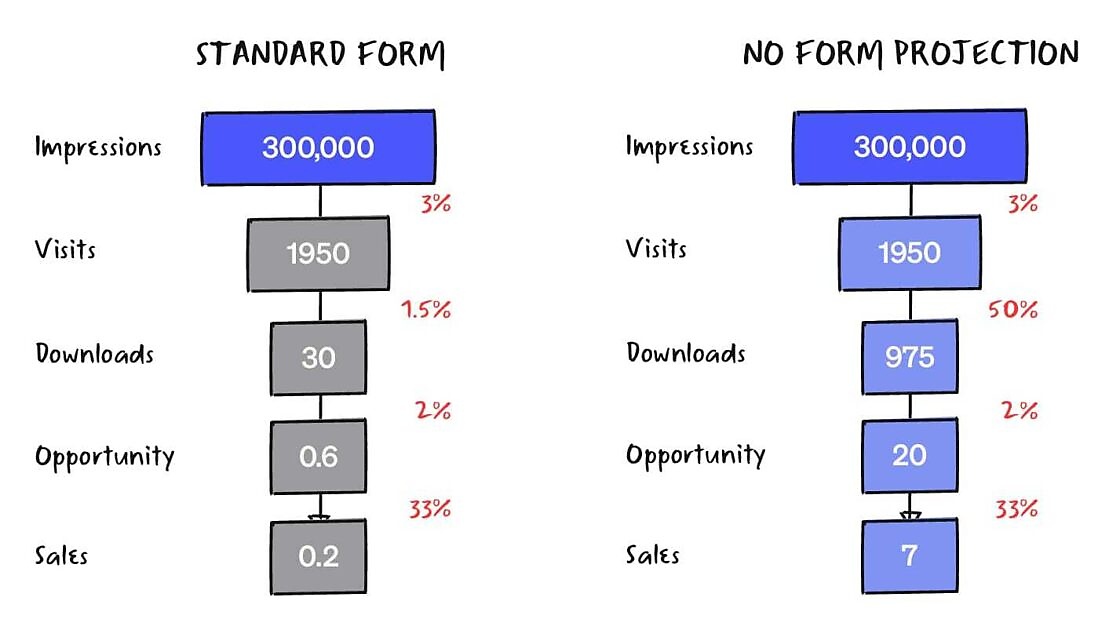Any fans (like me) of Malcolm Gladwell’s excellent Revisionist History may have come across his breakdown, in the episode “My Little Hundred Million”, of the difference between strong- and weak-link sports.
Basketball is a strong-link sport. If you’ve got Michael Jordan (in his 90s prime) on your team, then you can still win — even if you line him up with Laurel and Hardy or The Three Stooges.
But football (or soccer, for our friends across the pond) is a weak-link sport. You might have Lionel Messi on your team, but the addition of Bean and Chaplin would — probably hilariously — cost you the game.
In our view, B2B marketing is a weak-link sport. A good marketing campaign is (with some exceptions) only as good as its worst component, rather than its best.
Which is why it’s so detrimental when marketers overlook underperforming parts of their campaigns, simply because they seem insignificant, complicated, or too counterintuitive to argue against.
And one of the biggest campaign components that could be working against you?
Gated content.
The counterproductivity of gating content
Imagine you’re in a hallway, two doorways to either side of you. There’s a person standing beside each door, waiting to invite you in.
You turn to enter the first, and—
“Before you come in, leave your details at the door. Name (full name, if you please), job title, company, phone number, email address (no, not your personal one, your work one. Yes, we’ll be checking). And what are you interested in? Can we contact you again in the future?”
Urgh. But the second?
“Hey, come on in. If you want any help, come find us.”
Perfect.
The simple, obvious, no-duh fact is that none of us like being hounded for our personal details before we even dip our toe in. So… why do we insist on doing this with our marketing?
Especially considering the fact that content creation is, besides media, probably the most expensive, time-consuming, and potentially effective element of marketing.
It’s like buying a new Ferrari, driving it off the forecourt, onto the back of a truck and straight into long-term storage for only a few to see.
Ah yes, money’s worth.
Gating your best content isn’t the best practice people think it is. In fact, it’s a waste — and the cons are quickly outweighing the pros. Why? Because:
It’s a crap exchange — and people know it.
It asks your audience to supply something they value (their contact details) for something they’re on the fence about (your content).
It’s all or nothing.
There’s no middle-ground here — either people download your content, or they don’t. Which means they’ll either get a feel for the power of your brand and message… or, more likely, they’ll default to not bothering with it.
It stymies your campaign.
If success hinges on leads from gated content, you’re shooting yourself in the foot early. Very low conversion rates means everything else becomes redundant by default.
That last point in particular is something marketers need to focus on.
The hard truth: Gating your content isn’t gaining leads for you — it’s losing them
It doesn’t matter how good your content, or your targeting, or your media is, if people never get to see it. And that’s pretty much what happens when your form conversion rate is zero.
The problem is that people are more aware of what not gating costs them. Simplistically: No upfront leads.
But they rarely think about what it costs to gate. And it costs oh-so-much.
Loss of Brand Equity
Every lost download means a lost opportunity to inspire and galvanize on the back of the resources you’ve created. It also suggests uncertainty in your own message — why else would you need to bargain for details? (Do you not trust your content to speak well for you?)
Frustrated Users
You risk alienating potential customers by treating them like transactions and making them think you lack the imagination/expertise to earn their attention.
More Nurture Work
The leads that you get from initial sign-ups often require additional nurture flows and investment, as they deliver diminishing returns. They’re also less likely to be invested — which means you’ll need to work harder to get them on-side.

You can see the effects of gating in this funnel projection.
All the impressions and visits in the world mean nothing if you’re hemorrhaging people exponentially at every stage.
You can go from hundreds of thousands of relevant impressions, to a mere handful of downloads (and even fewer sales off the back of it).
We ran our own test on this a (long) while back. Even in the earlier days of online marketing, we saw super interested, high-intent visitors to our site drop out after coming face-to-face with a form. In today’s far more saturated market, we’d expect to face as high as a 98% drop-off rate.
The better way forward: Let it all hang out
There’s another (we’d argue, better) way. It takes courage, but you should think about it as an opportunity rather than a risk, as the results will be so much more in your favor.
You need to think differently. Look to convert further down the funnel.
Trust in the strength of your message and use the power of really good content to bring people to your door. And then continue to use well-thought-out targeted content to drive lower funnel activities. Simply by removing forms, one of our clients recorded download rates from their paid media campaigns going from 0.5% to 37%.

Case in point: You might lose out on those top-of-funnel leads, but you gain more (and more invested) conversions further down the funnel.
Why? Because more people will see your content, and will be able to self-qualify themselves into your sales funnel.
You still get names in your database — but they’ll be qualified leads rather than the mildly curious.
To do this successfully, you need to consider your campaigns as integrated processes — ones that bring together and connect all elements, so that potential weak points are shored up and transformed into strengths.
It’s not just about ungating assets. It’s about casting aside cheap, short-term small wins for more measured, long-term thinking that brings real gains.
Once content forms are removed, the question is whether you can galvanize users to take commercial actions. By aligning your galvanizing idea with clear, contextual action steps, you can get as much as 5x your current customer conversions from your content.
Improve your brand awareness, shore up satisfaction, cut down reliance on nurture, and bring better leads to your stakeholders.

Enjoyed this article?
Take part in the discussion








Comments
There are no comments yet for this post. Why not be the first?